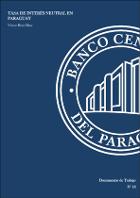| dc.creator | Ruíz Díaz, Victor |
| dc.date.accessioned | 2020-12-23T17:36:46Z |
| dc.date.available | 2020-12-23T17:36:46Z |
| dc.date.created | 2012-11-01 |
| dc.date.issued | 2012-11-01 |
| dc.identifier.citation | Banco Central Europeo (2004). Bolentín Mensual, Mayo. |
| dc.identifier.citation | Bernhardsen, T. and K. Gerdrup (2007). The neutral real interest rate, Norges Bank Economic Bulletin 2, pp. 52-64. |
| dc.identifier.citation | Calderón, C. y F. Gallego (2002): “La Tasa de Interés Real Neutral en Chile”, Economía Chilena 5(2): 65-72. |
| dc.identifier.citation | Castillo, P., C. Montoro y V. Tuesta (2006): "Measuring the Natural Interest Rate for the Peruvian Economy," Working Papers 2006-003, Banco Central de Reserva del Perú. |
| dc.identifier.citation | Echavarría, J., E. López, M. Misas, J. Tellez y J. Parra (2006): “La Tasa de Interés Natural en Colombia”, Banco de la República, Colombia. |
| dc.identifier.citation | Edwards, S. (2006): "The Relationship Between Exchange Rates and Inflation Targeting Revisited," NBER Working Papers 12163, National Bureau of Economic Re- search, Inc. |
| dc.identifier.citation | España, V. (2008): “La Tasa Natural de Interés: Estimación para la Economía Uruguaya”, Manuscrito, Banco Central del Uruguay. |
| dc.identifier.citation | Fuentes, R. y F. Gredig (2008): “La Tasa de Interés Neutral: Estimaciones para Chile”, Volumen11-N°2, Economía Chilena. |
| dc.identifier.citation | Galí, J. (2003): “New Perspectives on Monetary Policy, Inflation and the Business Cycle”, In “Advances in Economy Theory”, vol. III, Cambridge University Press. |
| dc.identifier.citation | Hodrick, R.J. and E.C. Prescott (1997): “Post-war U.S. Business Cycle: An Empirical Investigation”, Journal of Money, Credit and Banking, 29(1), 1-16. |
| dc.identifier.citation | Laubach, T. and J. Williams (2001): "Measuring the natural rate of interest," Finance and Economics Discussion Series 2001-56, Board of Governors of the Federal Reserve System (U.S.). |
| dc.identifier.citation | Lubik, T. and F. Schorfheide (2007): "Do central banks respond to exchange rate movements? A structural investigation," Journal of Monetary Economics, Elsevier, vol. 54(4), pages 1069-1087, May. |
| dc.identifier.citation | Mc Callum, B. and E. Nelson (2004): "Targeting vs. instrument rules for monetary policy," Working Papers 2004-011, Federal Reserve Bank of St. Louis. |
| dc.identifier.citation | Mésonnier, J. and J. Renne (2007): “A Time-varying Natural Rate of Interest for the Euro Area”, European Economic Review, Elsevier, vol. 51(7), pages 1768-1784, October. |
| dc.identifier.citation | Morón, E. and D. Winkelried (2005): "Monetary policy rules for financially vulnerable economies," Journal of Development Economics, Elsevier, vol. 76(1), pages 23-51, February. |
| dc.identifier.citation | Muñoz, E. y E. Tenorio (2007): “Estimación de la Tasa de Interés Real Neutral para la Economía Costarricence (1991-2006)”, Documento de Investigación, DIE-04-2007- DI, Banco Central de Costa Rica. |
| dc.identifier.citation | Orphanides, A. and Williams J. (2002): "Robust monetary policy rules with unknown natural rates," Working Papers in Applied Economic Theory 2003-01, Federal Reserve Bank of San Francisco. |
| dc.identifier.citation | Ruíz Díaz, V. (2012): “Cálculo del Lambda Optimo para la Economía Paraguaya”, Manuscrito en proceso de publicación, Banco Central del Paraguay. |
| dc.identifier.citation | Solera, A. (2003): “El Filtro de Kalman”, Nota Técnica, DIE-02-2003-NT, Banco Central de Costa Rica. |
| dc.identifier.citation | Stock, J. and M. Watson (1996): "Asymptotically Median Unbiased Estimation of Coefficient Variance in a Time Varying Parameter Model," NBER Technical Working Papers 0201, National Bureau of Economic Research, Inc. |
| dc.identifier.citation | Toit, L.C. (2008): Optimal HP Filtering for South Africa”, Stellenbosch Economic Working Papers 07/08, University of Stellenbosch. |
| dc.identifier.citation | Wicksell,K. (1898): “InterestandPrices”, London, Macmillan, 1936. Traslation of 1898 Edition. |
| dc.identifier.uri | http://repositorio.bcp.gov.py/handle/123456789/124 |
| dc.description | Este trabajo tiene por objetivo presentar algunas aproximaciones de la Tasa de Interés Real Neutral (TIRN) para Paraguay, teniendo en cuenta el rol que le compete en el marco de la política monetaria activa, variable que debe ser considerada como un insumo más dentro del conjunto de información a ser tenido en cuenta por las autoridades monetarias para la toma de decisiones. Para el efecto se utilizan metodologías univariadas, como promedio de tasa de interés real ex-ante y el filtro de Hodrick - Prescott; además se estima un modelo semi-estructural a través de la metodología del filtro de Kalman. Los resultados obtenidos para el periodo 1995 - 2011 sugieren que la TIRN para la economía paraguaya se encuentra en un rango comprendido entre 1,6% y 2 %. |
| dc.format.extent | 24 páginas |
| dc.format.mimetype | application/pdf |
| dc.language.iso | spa |
| dc.publisher | BCP |
| dc.relation.ispartof | Documentos de Trabajo |
| dc.relation.ispartofseries | Documento de Trabajo |
| dc.relation.isversionof | Documento de Trabajo; N° 18 |
| dc.rights.uri | http://creativecommons.org/publicdomain/zero/1.0/ |
| dc.subject | TASA DE INTERÉS REAL NEUTRAL |
| dc.subject | POLÍTICA MONETARIA |
| dc.subject | METAS DE INFLACIÓN |
| dc.subject | FILTRO DE HODRYCK - PRESCOTT |
| dc.subject | FILTRO DE KALMAN |
| dc.subject | PARAGUAY |
| dc.title | La tasa de interés neutral en Paraguay |
| dc.type | Working Paper |
| dc.subject.jelspa | C32 |
| dc.subject.jelspa | E43 |
| dc.subject.jelspa | E52 |
| dc.subject.keyword | NEUTRAL REAL INTEREST RATE |
| dc.subject.keyword | MONETARY POLICY |
| dc.subject.keyword | INFLATION TARGETING |
| dc.subject.keyword | HODRYCK - PRESCOTT FILTER |
| dc.subject.keyword | KALMAN FILTER |
| dc.subject.keyword | PARAGUAY |
| dc.rights.accessRights | Open Access |
| dc.type.spa | Documento de Trabajo |
| dc.type.hasversion | Published Version |
| dc.rights.cc | CC0 1.0 Universal |
| dc.rights.spa | Acceso abierto |
 This work is licensed under a Creative Commons Reconocimiento-NoComercial 4.0.This document has been deposited by the author (s) under the following certificate of deposit
This work is licensed under a Creative Commons Reconocimiento-NoComercial 4.0.This document has been deposited by the author (s) under the following certificate of deposit

